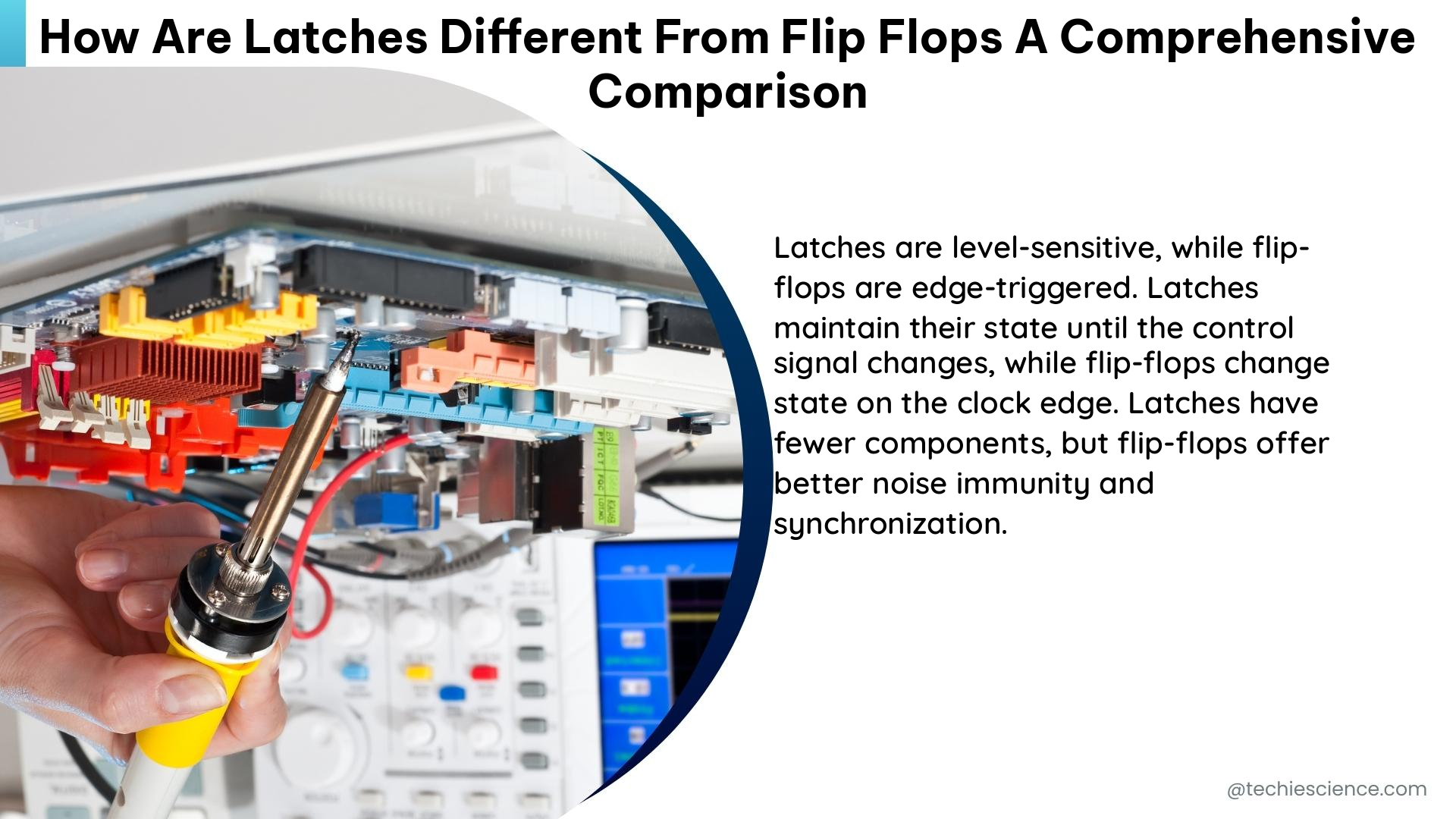Latches and flip-flops are fundamental building blocks in digital electronics, serving as memory elements in sequential circuits. While both are used to store bits, they differ significantly in their operation, sensitivity, clock signal, and power requirements. This comprehensive comparison delves into the measurable, quantifiable differences between these two crucial components.
Basic Principle
The primary distinction between latches and flip-flops lies in their triggering approach. Latches follow a level-triggered approach, where the output changes as soon as the input changes. In contrast, flip-flops utilize an edge-triggered approach, where the output changes only at the rising or falling edge of the clock signal.
Clock Signal

Flip-flops have a dedicated clock signal, while latches do not. This difference in clock signal affects the sensitivity and operating speed of these devices. Flip-flops are sensitive to both the applied input and the clock signal, whereas latches are sensitive only to the applied input signal when enabled.
Design Approach
Flip-flops can be designed using latches along with a clock, while latches can be designed using logic gates. This design approach highlights the fundamental differences in their underlying structure and functionality.
Operating Speed
Latches have a comparatively faster operating speed compared to flip-flops. This is due to the level-triggered nature of latches, which allows them to respond immediately to input changes, while flip-flops are limited by their edge-triggered nature.
Classification
Flip-flops can be classified into synchronous or asynchronous flip-flops, depending on their sensitivity to the clock signal. Latches, on the other hand, cannot be classified in this manner, as they do not have a clock signal.
Working Principle
Flip-flops work using binary input and the clock signal, while latches operate solely using binary inputs. This difference in the input requirements highlights the distinct approaches employed by these two memory elements.
Power Requirement
Flip-flops require more power due to their clock signal, which introduces additional power consumption. Latches, in contrast, require less power as they do not have a dedicated clock signal.
Circuit Analysis
Analyzing the circuit is generally more complex for latches compared to flip-flops. The level-triggered nature of latches can introduce additional challenges in circuit design and analysis.
Type of Operation
Flip-flops perform synchronous operations, where the output changes in sync with the clock signal. Latches, on the other hand, perform asynchronous operations, where the output changes independently of the clock signal.
Robustness
Flip-flops are comparatively more robust than latches. The edge-triggered nature of flip-flops makes them less susceptible to noise and other external disturbances, enhancing their reliability.
Operational Dependency
The operation of flip-flops relies on the present and past input bits, along with the past output and clock pulses. In contrast, the operation of latches depends on the present and past input, as well as the past output binary values.
Usage as a Register
Flip-flops can be used as a register due to their clock signals, which allow for the storage and retrieval of data. Latches, however, cannot directly serve as a register, as they require additional advanced electronic circuits to achieve this functionality.
Types
Both flip-flops and latches have similar types, including J-K, S-R, D, and T. These types differ in their input and output characteristics, catering to various digital design requirements.
Area Requirement
Flip-flops generally require more area on a semiconductor chip compared to latches. This is due to the additional circuitry required for the clock signal and the edge-triggered nature of flip-flops.
Applications
Flip-flops constitute the building blocks of many sequential circuits, such as counters, shift registers, and state machines. Latches, while also used in sequential circuit design, are not as widely preferred as flip-flops for these applications.
In summary, latches and flip-flops exhibit distinct differences in their operation, sensitivity, clock signal, power requirements, and usage. While latches are faster and require less power, flip-flops are more robust and suitable for synchronous operations. The choice between a latch and a flip-flop depends on the specific requirements of the digital design and the trade-offs between performance, power, and reliability.
References:
- Difference between Flip-Flop and Latch
- Difference between Flip-Flop and Latch
- Difference between Latch and Flip-Flop

The lambdageeks.com Core SME Team is a group of experienced subject matter experts from diverse scientific and technical fields including Physics, Chemistry, Technology,Electronics & Electrical Engineering, Automotive, Mechanical Engineering. Our team collaborates to create high-quality, well-researched articles on a wide range of science and technology topics for the lambdageeks.com website.
All Our Senior SME are having more than 7 Years of experience in the respective fields . They are either Working Industry Professionals or assocaited With different Universities. Refer Our Authors Page to get to know About our Core SMEs.